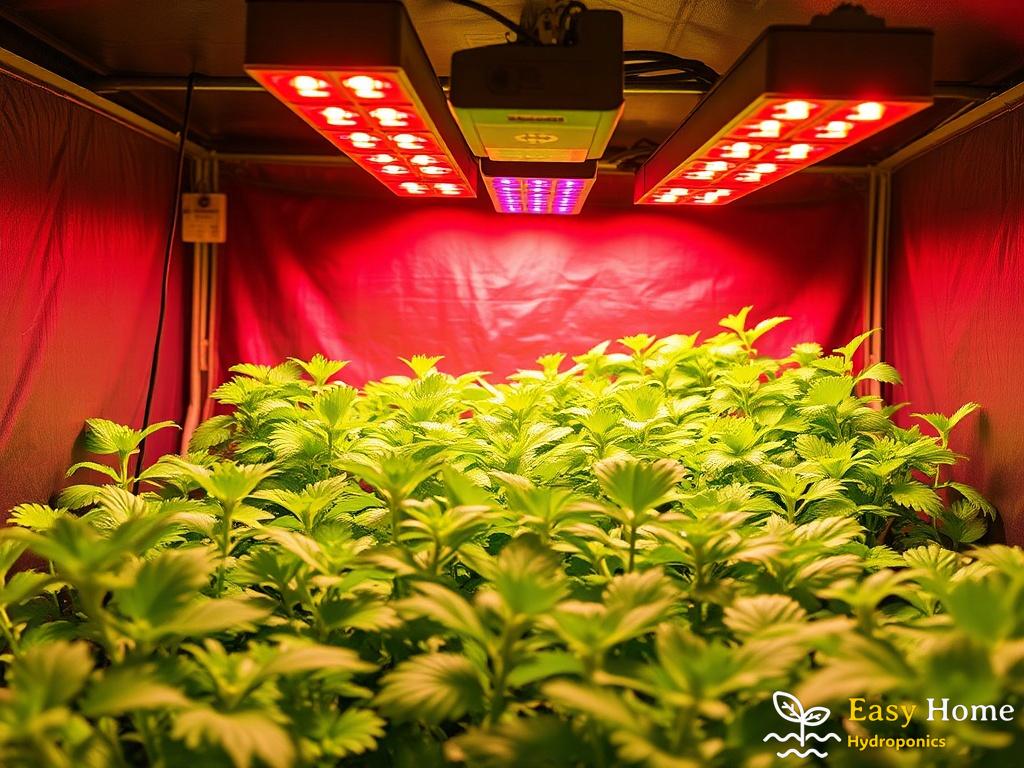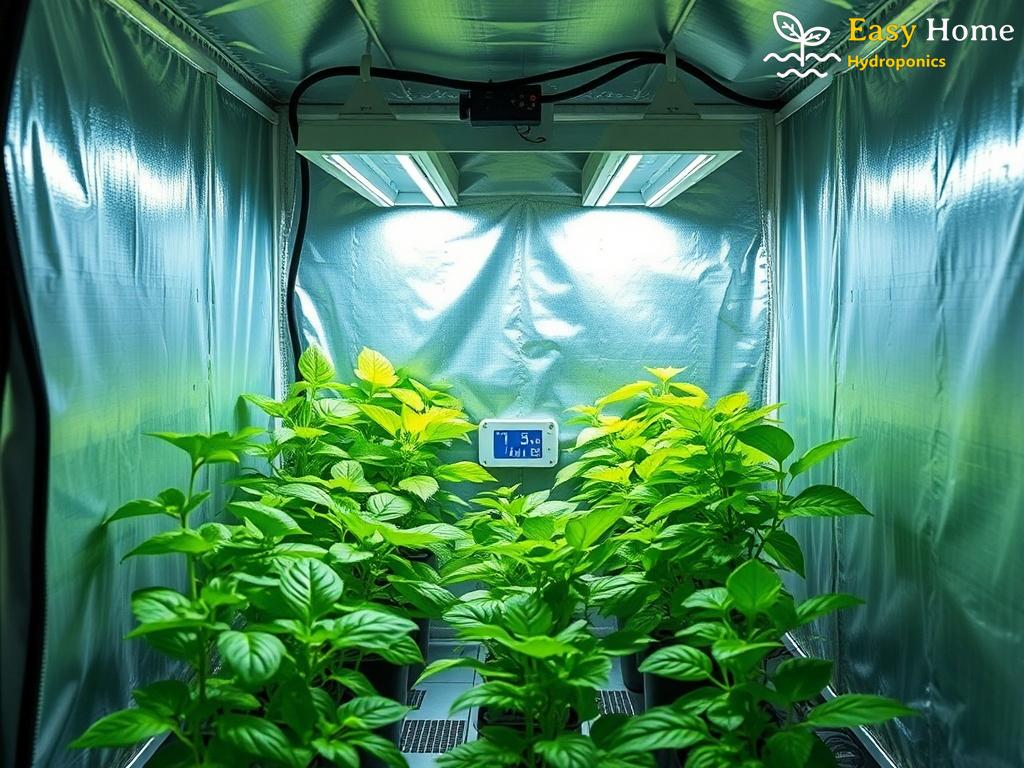The Perfect Match: Choosing Grow Lights for Hydroponics

Understanding the Spectrum of Light
When it comes to growing plants, light is not just light. Different wavelengths serve different purposes, and understanding this spectrum is crucial for hydroponic success. Plants use light for photosynthesis, but they have specific preferences that can affect their growth and yield. This is where grow lights come into play, providing the necessary light spectrum that mimics natural sunlight.
Key Light Spectrums:
- Blue Light: Essential for vegetative growth and leaf development.
- Red Light: Promotes flowering and fruiting, making it vital in the later stages of plant growth.
- Full Spectrum: A balanced combination that supports all growth stages, ideal for beginner hydroponic gardeners.
Types of Grow Lights: Finding Your Best Fit
As you venture into the world of hydroponics, the variety of grow lights available can be overwhelming. Each type has its own advantages and ideal applications, so knowing what suits your setup is crucial. Whether you’re a seasoned pro or a beginner, let’s break down the most popular types of grow lights.
| Type | Advantages | Best For |
|---|---|---|
| LED | Energy-efficient, long lifespan, low heat output | All stages of growth, especially indoor setups |
| HID | High intensity, great for large grows | Advanced growers with ample space |
| CFL | Cost-effective, easy to use | Small-scale, beginner setups |
Light Placement: The Golden Rule
Once you’ve chosen your grow lights, the next step is placement. The height and positioning of your lights can dramatically influence your plants’ growth. Too close, and you risk burning the plants; too far, and they may stretch towards the light, leading to weak stems. Remember, finding that sweet spot is key.
In general, keeping the lights about 12 to 24 inches above your plants is a good rule of thumb, but always monitor your plants’ responses. Adjust as necessary to ensure they receive optimal light without stress.
Maximizing Space: Strategic Light Placement in Tents

When setting up a hydroponic tent, the arrangement of your grow lights can significantly influence not only the health of your plants but also the efficiency of your space. Proper light placement is a crucial factor that ensures your plants receive adequate illumination while maximizing the square footage of your grow area. With careful consideration, you can create an environment that promotes robust growth without wasting precious tent space.
Understanding Light Coverage is essential for achieving optimal growth in your hydroponic tent. Grow lights emit light that can vary in intensity and spread, and it’s important to recognize how this affects the plants below. Positioning your lights too close may lead to light burn, while placing them too far can result in insufficient light, causing plants to elongate and weaken. The ideal setup ensures that every plant receives uniform light exposure, promoting healthy foliage and maximizing yield.
One clever approach to strategic light placement is utilizing the vertical space within your hydroponic tent. By hanging lights from adjustable hangers, you can easily modify the height as your plants grow. This flexibility not only helps in maintaining the right distance but also allows you to target different plant growth stages. For example, as seedlings emerge, lights can be positioned closer to encourage robust initial growth, then gradually raised as the plants mature.
| Light Type | Ideal Height Above Plants | Best Coverage Area |
|---|---|---|
| LED | 12-18 inches | Wide coverage, suitable for full tent |
| HID | 24-36 inches | Focused light, best for larger areas |
| CFL | 6-12 inches | Close proximity, ideal for small setups |
Additionally, utilizing reflective materials within your hydroponic tent can bolster light efficiency. By lining the walls with mylar or other reflective surfaces, you can enhance light distribution, ensuring that every corner of your tent is bathed in optimal lighting. This is particularly important in smaller tents where light loss can be a significant issue. The combination of strategic light placement and reflective surfaces works together to create a harmonious growing environment.
In summary, maximizing space through thoughtful light placement in hydroponic tents is not just about aesthetics; it’s about creating a sustainable ecosystem for your plants. By understanding how different light types interact with plant growth and leveraging vertical space along with reflective materials, you can ensure that your hydroponic setup is both efficient and effective.
Light Spectrum Secrets: Boosting Plant Growth

Unlocking the Power of Photosynthesis
In the intricate dance of plant growth, light plays a pivotal role, acting as the very lifeblood that fuels photosynthesis. However, not all light is created equal; different wavelengths have unique effects on plant development. By understanding the nuances of the light spectrum, hydroponic gardeners can harness its power to significantly enhance plant growth and yield. This knowledge transforms a mere hobby into a flourishing endeavor.
The Impact of Light Wavelengths on Growth Stages
Plants are particularly responsive to specific wavelengths, which makes it essential for hydroponic growers to tailor their lighting setups accordingly. Blue light is crucial during the vegetative phase, stimulating robust leaf growth and compact plant structure. Conversely, as plants transition to their flowering stage, they require an influx of red light to encourage blooming and fruit production. It’s fascinating to note that some advanced setups utilize a combination of both red and blue light, creating a full spectrum environment that caters to every growth stage. This approach not only boosts overall health but also maximizes yield, proving that a well-thought-out light strategy is indispensable.
Optimizing Your Hydroponic Environment
To take full advantage of the benefits provided by various light spectrums, it’s imperative to integrate them seamlessly into your hydroponic tent setup. Utilizing adjustable LED grow lights can enhance flexibility, allowing you to modify light intensity and spectrum as your plants develop. Furthermore, incorporating smart technology to automate light schedules can ensure that your plants receive the precise amount of light they need, mimicking the natural day-night cycle. When aligned with optimal light placement and reflective materials, this integration creates an environment where plants not only survive but thrive, showcasing the art and science behind successful hydroponics.
Energy Efficiency: Powering Your Hydroponic Setup
As hydroponic gardening gains popularity, the focus on energy efficiency has never been more critical. Maximizing the potential of grow lights while minimizing energy consumption can lead to significant savings and a more sustainable gardening practice. Understanding how to integrate energy-efficient lighting solutions into your hydroponic tent setup not only benefits your plants but also your wallet.
Harnessing the Power of Energy-Efficient Lighting
When considering energy-efficient options, LED grow lights emerge as champions in the hydroponic arena. These lights consume significantly less electricity compared to traditional HID or CFL lights, while still delivering a powerful light spectrum that is essential for plant growth. The long lifespan of LEDs—often exceeding 50,000 hours—means fewer replacements and lower long-term costs. This efficiency translates into a lower carbon footprint, making your hydroponic setup not just productive, but also eco-friendly.
The Balance of Light Intensity and Energy Consumption
Finding the sweet spot between light intensity and energy consumption is crucial. While many growers may be tempted to crank up the wattage for maximum light output, it’s essential to understand that more light isn’t always better. Striking a balance ensures that plants receive adequate illumination without excessive energy expenditure. Employing smart technology, such as timers and light dimmers, allows for tailored light schedules that align with the natural growth cycles of your plants, optimizing both growth and energy use.
Comparing Energy Costs: A Closer Look
Many hydroponic enthusiasts may wonder how energy-efficient options stack up against traditional lighting methods. To provide clarity, here’s a simplified comparison:
| Light Type | Average Wattage | Expected Lifespan | Annual Energy Cost (Approx.) |
|---|---|---|---|
| LED | 300W | 50,000 hours | $70 |
| HID | 600W | 20,000 hours | $140 |
| CFL | 150W | 10,000 hours | $50 |
This table underscores the importance of considering not just the initial purchase price of grow lights but also their energy consumption over time. By investing in quality, energy-efficient lighting, hydroponic gardeners can enjoy robust plant growth while keeping operational costs low.
Automating Light Cycles: Smart Solutions for Hydroponics
In the fast-evolving world of hydroponics, the quest for perfection doesn’t stop at choosing the right grow lights or their placement. The integration of smart technology to automate light cycles has emerged as a game-changer for hydroponic gardeners. This innovation not only simplifies the growing process but also ensures that plants receive optimal light exposure tailored to their needs, ultimately enhancing growth and yield.
Harnessing Smart Technology for Efficiency
Imagine a scenario where your hydroponic setup operates on autopilot, adjusting light conditions based on your plants’ growth stages. Smart technology provides the tools to achieve this level of automation. By utilizing timers, light sensors, and smart controllers, gardeners can create customized light schedules that align with the natural circadian rhythms of plants.
These automated systems can be programmed to mimic the gradual transition of daylight and twilight, promoting a more natural growth environment. For instance, a gradual ramp-up of light in the morning can stimulate plant metabolism, while a slow dimming in the evening can signal the end of the day, enhancing the overall health of your plants.
Benefits of Automated Light Cycles
Embracing automated light cycles in your hydroponic tent setup offers a multitude of advantages:
- Consistency: Automated systems provide uniform light exposure, reducing the risk of light stress and ensuring that all plants receive the same conditions, which is crucial for consistent growth.
- Energy Savings: By optimizing light schedules, you can significantly cut energy costs, as lights will only operate during specific hours tailored to your plants’ needs.
- Ease of Use: With set-and-forget functionality, you can focus more on other aspects of your hydroponic garden, such as nutrient management and pest control, rather than constantly adjusting your lighting system.
Integrating Sensors for Real-Time Adjustments
To take automation a step further, integrating light sensors into your hydroponic setup can provide real-time feedback. These sensors can detect ambient light levels and adjust grow light intensity accordingly. For example, on particularly sunny days, the sensors can dim the grow lights to prevent overexposure and conserve energy. This dynamic adjustment ensures that your plants receive the optimal amount of light, regardless of external conditions.
In conclusion, automating light cycles in hydroponic setups not only enhances plant health and growth but also streamlines the gardening process. By integrating smart solutions, hydroponic gardeners can enjoy the dual benefits of efficiency and effectiveness, taking their gardening endeavors to new heights.




